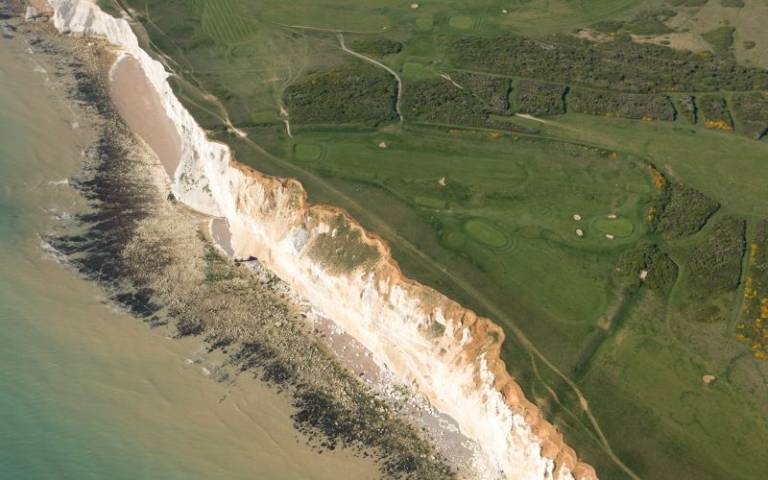Seaford Head, a nationally important heritage site at increasing risk of coastal erosion related to accelerating climate change, is being investigated and recorded under a new initiative involving Archaeology South-East, part of UCL's Institute of Archaeology.

Improved understanding is a necessary first step in the process of managing the loss of an archaeological site, and the Seaford Head Project is trialling ways of achieving this including 3D modelling and surveying the site with drones. The project will also trial the use of podcasts and videos to engage local communities in a conversation about coastal change and how they feel about the eventual, inevitable loss of historic sites.
The team and their partners have begun capturing the nationally important archaeology of Seaford Head, East Sussex, before it is lost to coastal erosion. The headland, which includes an Iron Age hillfort and provides the iconic view of the Seven Sisters cliffs, has seen significant cliff collapses in the last year. The erosion is expected to increase in frequency and severity with predicted rises in rainfall and storm events related to climate change.
Jon Sygrave, project manager for Archaeology South-East, said: "Seaford Head is a striking and beautiful site featuring archaeology of multiple periods, including a Bronze Age bowl barrow (a type of burial mound), an Iron Age hillfort and a Second World War reinforced concrete structure.
"Using a combination of non-intrusive archaeological techniques, we are assessing and recording the threatened heritage on Seaford Head. This includes desk-based analysis of historic maps, and aerial, topographic and geophysical survey, and could result in the discovery of previously unknown heritage assets.
"A crucial part of this is using a drone to capture archaeological features exposed in the cliff and accurately map the site's earthworks to create a 3D model of Seaford Head, preserving its complex heritage for future generations."
The investigations at Seaford Head will be used to provide a case study and template for other heritage agencies, landowners, and community groups facing similar threats to their local heritage to help plan and deliver local responses.
The project is funded by £18,975 from Historic England with contributions from the South Downs National Park Authority (SDNPA). It draws together the expertise of UCL archaeologists from Archaeology South-East, artists and videographers along with several key stakeholders, principally Seaford Town Council, the SDNPA and Historic England.
Marcus Jecock, Senior Archaeological Investigator and Coastal Lead at Historic England, said: "Coastal erosion is not a new threat, but climate change is accelerating the rate at which erosion is happening and thereby the rate at which archaeological sites of all types that exist around our coasts are being lost - often without proper record.
"The hillfort on Seaford Head is a scheduled monument, meaning the archaeology here is recognised as nationally important. We, as a nation, cannot build sea defences to protect every stretch of coastline against erosion, so earlier this year Historic England added the site to the Heritage at Risk Register in recognition of the threat it faces.
"At the same time, we have commissioned Archaeology South-East to map the visible, above-ground remains in detail and to conduct a geophysical survey to give us a picture of buried features within the interior. Funding this work will help us make informed decisions on the long-term management and recording of the monument, before it falls completely in to the sea."
Adam Chugg, Town Clerk of Seaford Town Council, said: "As well as its archaeological significance, Seaford Head is an important area of Chalk Downland landscape, which includes a nature reserve managed by the Sussex Wildlife Trust, and a golf course run by Seaford Town Council.
"As owners and custodians of the site, we look forward to learning more about the fort before the remaining parts of it are lost to coastal erosion."
An important part of the project is to engage the community with the findings and include the public in conversations about heritage loss between experts and policy makers.
Anooshka Rawden, Cultural Heritage Lead at the South Downs National Park Authority, said: "This project is not only both exciting and timely given we know very little about this site, but it will also give us an opportunity to open up the conversation about heritage loss linked to landscape change.
"The project will produce films and podcasts to open up discussions about heritage loss, and help us understand how the public feel about change and loss of this kind, particularly where we have perhaps become disconnected with the heritage in our landscape. We have the chance to rediscover lost stories that reveal the deep time of the South Downs."
Artist and writer Alinah Azadeh will be working with the Seaford Head Project team to create a short spoken-word performance on film reflecting both the archaeological findings and the wider issue of landscape change and heritage loss. Working with an artist gives the project an opportunity to broach loss more broadly, touching more emotively on our relationships with place and time.
The Seaford Head Project is running over the autumn and winter. To keep up to date, please visit the project website at https://www.ucl.ac.uk/archaeology-south-east/seaford-head or follow #SeafordHeadProject on Twitter, Facebook and Instagram.






